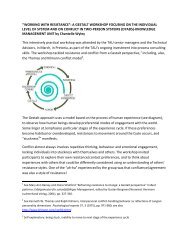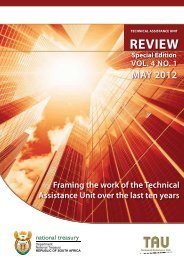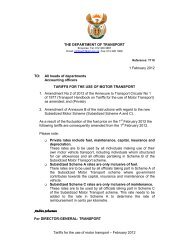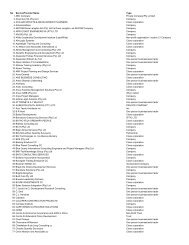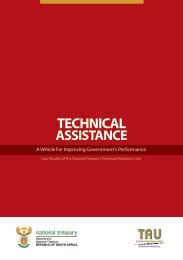Review 3 final 2 - TAU - National Treasury
Review 3 final 2 - TAU - National Treasury
Review 3 final 2 - TAU - National Treasury
You also want an ePaper? Increase the reach of your titles
YUMPU automatically turns print PDFs into web optimized ePapers that Google loves.
TECHNICAL ASSISTANCE UNIT REVIEW | The Reality as well as the Buzz<br />
The Reality as well<br />
as the Buzz:<br />
Assuring<br />
Governance within<br />
Public Entities<br />
In South Africa, Public Entities can be placed into two<br />
broad categories based on their level of autonomy.<br />
The first are Government Business Enterprises (GBE),<br />
which operate like private entities in the open market,<br />
generating an income, paying taxes and, in some<br />
cases, paying dividends. The second kind of Public<br />
Entity is that which is an extension of a government<br />
department and which performs a specific function on<br />
behalf of government. This kind will derive its annual<br />
budget from the relevant department.<br />
The common thread with the two types of Public<br />
Entities is that they are not only accountable to their<br />
“<br />
delivery of services.<br />
Boards, but also to the Executive and Legislative arms<br />
of the state as well as the citizens of this country (see<br />
Diagram and Text Box on page 13).<br />
But what does this all mean<br />
The importance of a reliable and effective set of<br />
checks and balances within any entity, whether public<br />
or private, is an assurance to stakeholders that the<br />
organisations representing their interests are managed<br />
soundly and ethically. This would underscore values<br />
such as accountability, integrity, leadership and<br />
transparency without which the aforementioned<br />
assurances cannot be met. Accountability is the critical<br />
concept of ‘governance’-be it buzz word or realityit<br />
is the mechanism that ensures that these critical<br />
assurances can be met.<br />
Given that these organisations are in place to meet the<br />
needs of the people, governance in these organisations<br />
is not meant to be static nor rigid; rather, it is an<br />
iterative process, being shaped and refined as and<br />
when it is necessary to live up to diverse stakeholder<br />
requirements, yet with layers and levels constitutionally<br />
guaranteed (see Diagram and Text box on page 14).<br />
Public Entities are established in the Public Sector, but outside the Public Service, typically for reasons of -<br />
(a) Strategic, social or economic intervention by the State or to deal with strategic risks and dangers that the State or<br />
society faces to its security, health, prosperity or wellbeing; and/or<br />
(b) Adopting commercial and business principles in service delivery when it is required; and/or<br />
(c) Signalling that there is need for objectivity and more operational autonomy, yet retaining accountability in the<br />
”<br />
12<br />
page<br />
Enabling change for development



